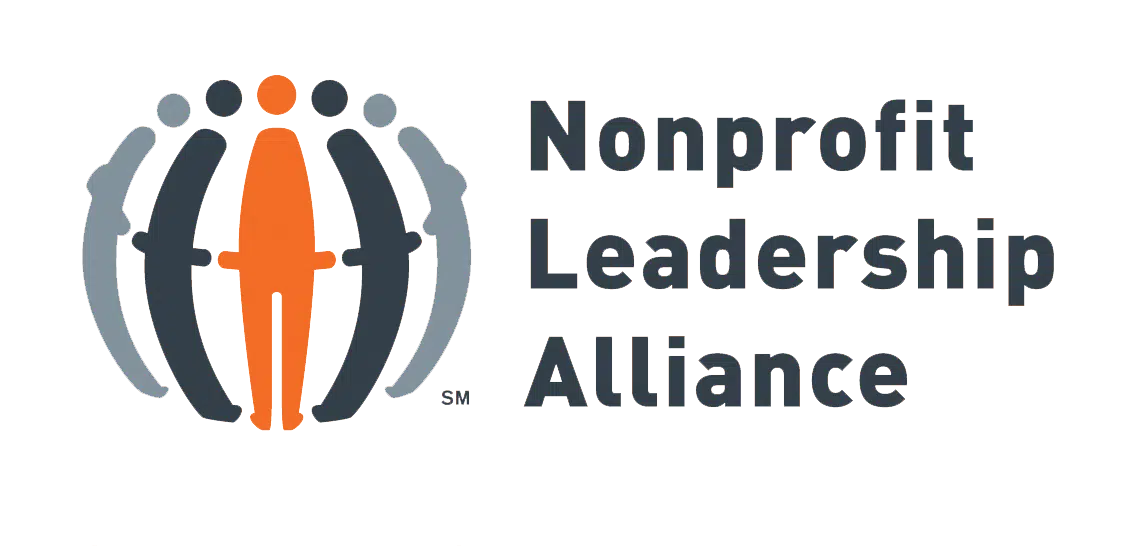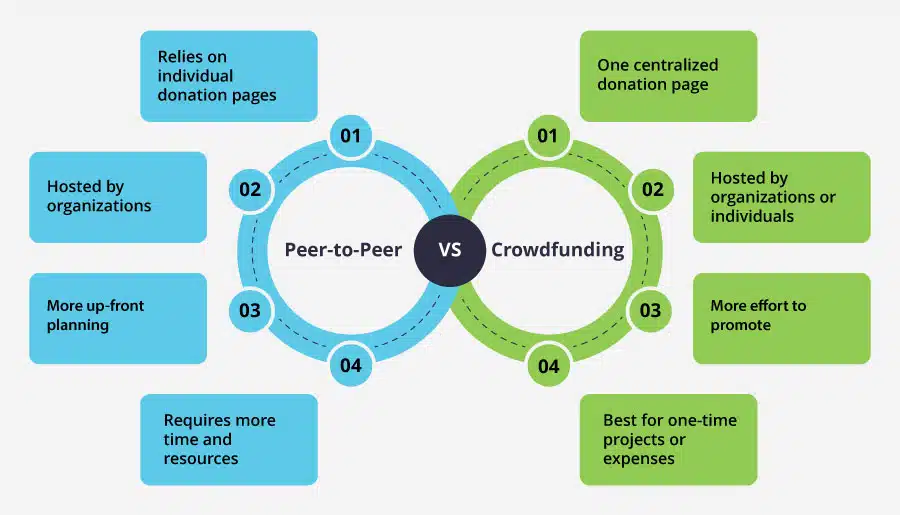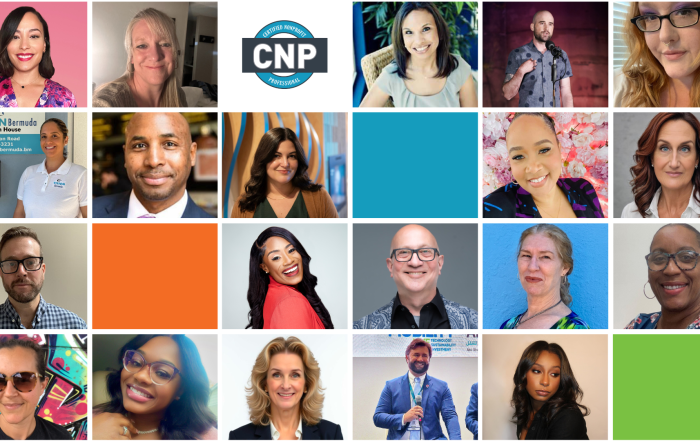Even though they’re similar, there are a few crucial differences in how to choose between peer-to-peer fundraising and crowdfunding, how to prepare for each type of campaign, and how to drive them to success. We’ll be looking at these differences through five important questions:
- What are peer-to-peer and crowdfunding campaigns?
- Who uses each type of campaign?
- How do peer-to-peer and crowdfunding campaigns work?
- What do I need to get started?
- Which one should I choose?
After gaining a better understanding of the key differences between peer-to-peer fundraising and crowdfunding, you’ll be well-equipped to pick whichever is best for your purposes and get a start on running a successful campaign.
What are peer-to-peer and crowdfunding campaigns?
Both crowdfunding and peer-to-peer campaigns are methods of fundraising that utilize personal networks and social media sharing.
What is a peer-to-peer campaign?
With peer-to-peer fundraising, volunteers set up their own fundraising pages and personally call on friends and family to donate. The resulting funds go toward the volunteers’ nonprofit of choice.
What is a crowdfunding campaign?
On the other hand, an organization may set up a crowdfunding page for a specific, time-bound project, or individuals can create one for their own personal causes. As Fundly’s crowdfunding website guide explains, these causes may range from medical expenses to artistic projects to scientific research.
What distinguishes these campaign types?
While both are focused on garnering as many individual donations as possible, for crowdfunding, people donate to one source that an individual or organization has set up. In a more decentralized peer-to-peer fundraiser, individuals can each share their own donation pages on behalf of an organization, with donations flowing to the nonprofit.
The difference: Peer-to-peer fundraising relies on individuals who fundraise on behalf of the organization through personalized giving pages. Crowdfunding is more centralized, facilitating donations through a single campaign page hosted by the organization or individuals receiving funding.
Who uses each type of campaign?
Organizations can run both peer-to-peer fundraising and crowdfunding campaigns, but typically, individuals do not run peer-to-peer fundraising campaigns since they require a wider network of dedicated volunteers.
Crowdfunding offers a more flexible fundraising solution since it relies on just one online page to spread the word. This page consolidates key information and provides a single resource the host can edit and update throughout the campaign.
The difference: Organizations host peer-to-peer campaigns since they require more upfront resources, but organizations and individuals alike can easily host crowdfunding campaigns for one-time projects or expenses.
How do peer-to-peer and crowdfunding campaigns work?
To host a peer-to-peer or crowdfunding campaign, you’ll start with the following steps:
- Set a fundraising goal to give your campaign something to work toward.
- Create a crowdfunding page or a central peer-to-peer campaign page that explains your goals.
- If you’re hosting a peer-to-peer campaign, set up participant pages. Peer-to-peer fundraising software should make it easy for supporters to quickly launch and personalize their own pages.
- Share your fundraiser through social media, email newsletters, and personal connections. In a peer-to-peer fundraiser, actively encourage and empower your participants to use their personal networks to secure donations on their individual participant pages.
Crowdfunding takes much less planning than a peer-to-peer campaign and focuses on running your singular fundraising page. For a peer-to-peer campaign, in addition to donation pages, you’ll need to come up with a more specific plan for executing your campaign, training volunteers to fundraise, planning any events tied into the campaign, and/or an event to mark the end of the campaign.
The difference: Crowdfunding takes less pre-planning but more effort from the organization to spread the word on social media, while peer-to-peer takes more up-front planning and background management but requires less day-to-day fundraising work from the organization.
What do I need to get started?
For a crowdfunding campaign, you’ll need a fundraising page. You’ve likely heard of platforms like GoFundMe, which many individuals use, but there are lots of alternative websites that may better suit your needs as a nonprofit organization rather than an individual.
Peer-to-peer fundraising requires more software and planning. You’ll want to make sure you have enough staff and the proper management skills to smoothly execute a peer-to-peer campaign.
Additionally, Getting Attention’s digital fundraising campaign guide suggests consulting your nonprofit marketing plan to ensure your fundraising and marketing efforts align. Create a thorough plan that outlines your donor segments and includes ideas for how to reach those groups in your campaign.
The difference: A crowdfunding campaign requires a single donation page that’s shareable, but peer-to-peer fundraising requires more software, people, and time.
Which type of campaign should I choose?
Your decision will largely depend on the size and nature of your organization and your particular fundraising goals for the campaign. As mentioned in the last section, you’ll need specific resources and enough staff to help you train your participants if you want to host a peer-to-peer fundraiser.
Here are some signs that a peer-to-peer fundraiser may be best for your organization:
- You have a large and capable staff.
- You have a lot of passionate and engaged supporters.
- You have the time and resources to plan a longer, more complex campaign.
- You have an upcoming major event and want to raise awareness and online donations leading up to it.
Alternatively, these characteristics are better suited for crowdfunding:
- Your staff is small.
- You’re raising money for a one-time expense or time-bound project.
- You have the time to regularly update a campaign page and share new developments with your supporters.
- You have the time and means to share your message widely.
It’s very possible that you may be able to use both types of campaigns for different fundraising purposes. Especially since crowdfunding is better suited to one-time or infrequent fundraising, your organization can use both to raise funds and get your supporters more involved year-round.
As you develop your fundraising plan, don’t forget to implement donor and peer-to-peer participant appreciation strategies. Whether you express your thanks through automated messages, gifts, or thank-you notes, take the time to show your appreciation for the people who made your campaign possible.
Did you enjoy this story?
Get nonprofit tips and tools delivered right to your inbox by joining The Nonprofit Leadership Alliance Newsletter. Our bimonthly newsletter will make sure you know what’s happening with our network of social sector leaders.
Types of Tools to Strengthen Your Grants Compliance Approach
When grant funding is an important revenue source, grant compliance becomes critical to nonprofit success. Without it, grant funding could be jeopardized, putting vital programs and initiatives at risk. This makes optimizing your grants compliance
Introducing April 2025’s Certified Nonprofit Professional (CNP) Cohort
The Nonprofit Leadership Alliance is proud to introduce April 2025’s Certified Nonprofit Professional (CNP) Professional Track cohort! This group of nonprofit professionals have begun their six-month journey, participating in one of only four cohorts offered
How Darcy Swan, CNP, Leads Youth Development at the YMCA of Greater Kansas City
Amid a whirlwind of shifting priorities and tight deadlines looming in 2025, Darcy Swan, CNP, does what she always does. She pauses to make space for people. Her team had been stretched thin. Last-minute changes




